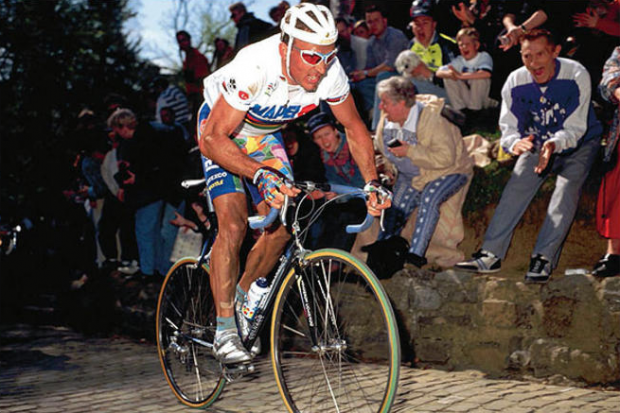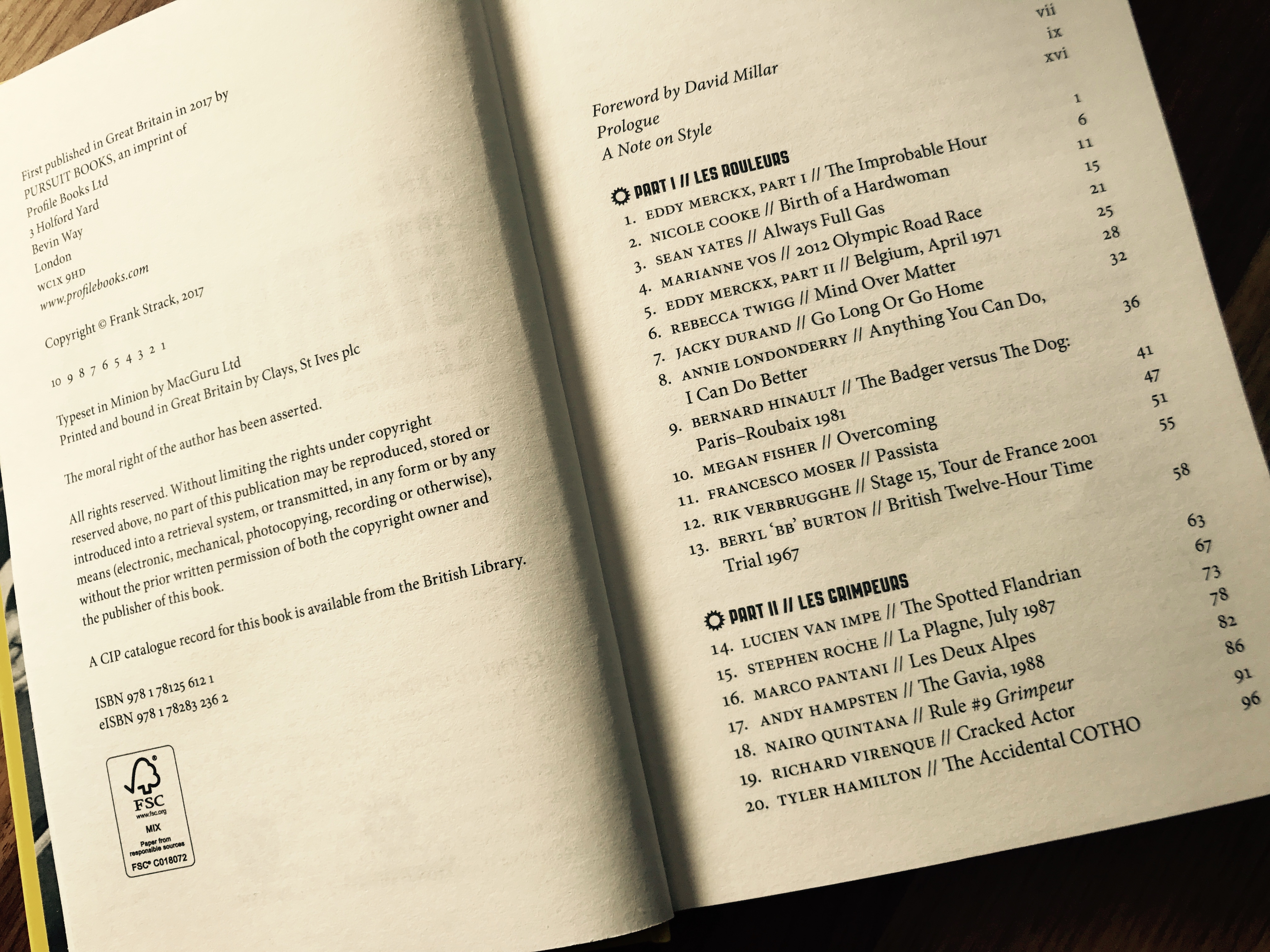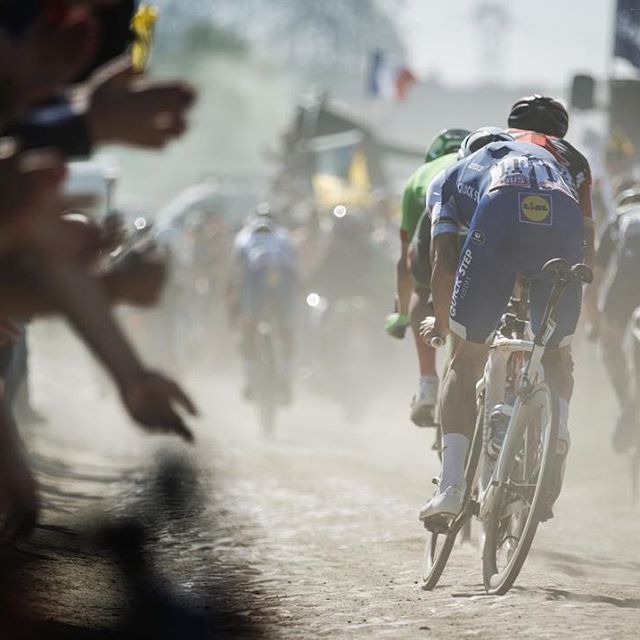Look Pro: The Flemish Compact

Everyone knows that the quality of one’s character is measured by the size gear they can push, particularly when going uphill. It is also a well-established fact that no self-respecting Flemish Pro would ever ride a Compact, no matter what condition their knees are in or how ferocious the gradient. Which, by extension, means that Compacts are for sissies. In fact, a true Flandrian would rather lose their national race than ride a Sissy Gear.
The first time we rode with Johan Museeuw, we were shocked to find him aboard one of his carbon/flax race machines – and a compact chainset. Not wanting to offend an Apostle by suggesting he’s riding his son’s bike, I asked him what he thought of it. “I don’t like it. The big ring isn’t big enough for climbing.”
The standard Flemish chainset is – and has been for as long as the Ancients have tracked these details in their sacred scrolls – either a 53T or 52T outer ring paired to a 42T inner ring. On the occasions when the parcours will see them scaling the Koppenberg or Kapelmuur, the Belgians make a concession and dust off their trusty 41T inner ring in order to shorten the gear by a whopping single tooth. In the mountains or over in Wallonia (the land of savages) where they are far from the prying eyes of their proud public, the Flemish hardman may allow his mechanic to bolt on a lowly 39T ring, so long as no one brings it up at the dinner table. (It is worth noting that in Cyclocross it is standard practice to ride a 38T inner ring.)
Museeuw has never been a grimpeur, not when he was a Pro and not now. On Keepers Tour 2013, we had the opportunity to do several more rides with him, one of which was over the roads of Liege-Bastogne-Liege. It was customary for him to suggest alternate routes that avoided the steep hills, and so it was that he tried to talk us out of riding the Stockeu. We rode up side-by-side, taking our time. As we alternated between pedaling and doing track stands, he asked if I was riding a compact. I feigned a combination of exasperation and insult at such a question and told him it was a Flemish Compact.
“Oh, a 39? Goed.”
[dmalbum path=”/velominati.com/content/Photo Galleries/frank@velominati.com/Belgian Compact/”/]


I just finished up The Rules last night and perhaps my favourite entry was that accompanying Rule #90. The Apostle is definitely badass. ‘The big ring isn’t big enough for climbing’ – I don’t know that I’d even say that about my cross bike.
museeuw is only a doper!
I had a compact that came on my #1. I rode it for a season, but it never felt quite right. I switched to 53/39 (run 11/25 in the back), and even on the really big climbs around these parts, I seem to be faster (as evidenced by comparing on a site that has segments, that I may or may not use). Don’t think I’ll go back until my knees blow up.
Yup, feel the same way about them, scaler. My steel Casati has a compact and I have never, ever liked it. If my damn cx crankset hadn’t died I could have put those funds towards a standard crankset. Gonna swap that out as soon as I can. My legs just don’t get along with it. Ha, I’ve now got a Flemish compact on my cx bike, the 39 ring that came with the standard road crankset looks better than my 38 cross ring, paired with a 46.
How could you not ride like a stud in that kit, on that bike, with a white hairnet and those shades?
I’ve been riding a lot in basic kit, blacks and whites. Yesterday I pulled on an old multi-colored Lotto jersey. Damn, it was fun to get some color back in my life!
It doesn’t matter what chainring size I could afford to put on my bike. I would still suck.
timely post as i just picked the braquets for my new #1 : 52-42 and 12-25
(was running 51-39 and 11-23)
As a mountain biker first who has now crossed over to the smoother side of things, the compact feels right for me at this point. I do feel like I’m cheating and hope to grow up to the full 53-39 soon. I’m always in awe as I watch the pros climb in the big plate and hate it when I try and succumb to the down shift.
I am currently building my new Number 1; going with a 110bcd crankset, giving me the ability to go 52×38, 52×36 or 50×34. I think it is a pretty good compromise. Personally I never felt the need for a 34 chainring, but I am dreaming of riding Mount Evans next summer, where I am sure to find The Man With The Hammer. Maybe the 34 will allow me to delay the meeting.
Or you could meditate on Rule #5.
Rode the Audax ACE250 route as part of a small group earlier in the year, from Bright over Mt Hotham, Falls Creek and Tawonga Gap. 53-39 on front, 11-23 on rear. Ok, not seriously badass, but the back side of Falls Creek after Mt Hotham and 160km would get testy in the big ring. No compacts for me, thank you very much. http://www.cyclingprofiles.com.au/HTM/Audax/REC_ADXACE250.htm
My new steed was too good a deal to pass up, and also came with sissy gears. Goes without saying when Breeding and Blimping for the second time, budgetatus isn’t what is once wasitatus.
On debut I barely ever got out of big ring. Quite strange with such a big ranging cassette also, not sure I like the linear feel of the top, with the bottom having large gaps. The mathematics (no math or maths arguments here!) of gearing fascinates me.
I have no doubt a Flemish Compact and straight block would feel better once the legs were up to it.
Crankset is one of the main things on my list right now, not sure if I want to go standard or compact. 34 is too small for winter base training. Contemplating 52/36 or maybe Osymmetrics which would be a whole ‘nother bag of worms.
The shop I bought from basically refused to change my gearing out, so I have 50/34 12-28 and I often find myself rationalizing the bailout gear at the end of a long ride. Anyone use Osymmetrics here?
I’ve just met up with the idea of gearing on the learning curve of cycling (took me 10 months to get here) so I took in this article with great interest. Quite honestly I’ve been a bit confused over what constituted a compact chain ring so this helped quite a lot!
After reading this I looked up the specs on my bike 52/36 – compact. Gag! I’ve been thinking about ditching my 11-28T cassette for something with a 16T for less cadence variation through the heart of the gearset but was a little worried about losing the 28 tooth cog for climbing. Now to find out that I’ve got the Nancy ring at the front as well was a huge hit to my self image – namely me as hill climbing assassin.
But then…
I remembered that when I bought my bike we swapped out the FSA crank for a Shimano 105 and lo and behold it’s a 52-39T. Whew! I’m okay with the Flemish Compact!
As an aside…any thoughts on cassette choices – 12-25T or 12-27T? Or is there an Ultegra cassette that would work that I should consider?
I do get the gist of the article and my first road bike, a lovely steel Ciocc had a 52/42 and I did like it a lot. I was young(er). Many years have now passed and anyway that was the bike squished by the pick up truck I have spoken of recently. Go compact and just pedal faster. 50 x 12 at a decent cadence is plenty quick. Get yourself some track time and develop souplesse if you want to look really Pro. Why grind and mash, bob and wobble if you can spin and look smooth?
We’ve not all got the guns of a pro but we can pretend. Just saying.
@kixsand 39 x 27T and 36 x 25T. Effectively same gear size. For me nothing I haven’t got up on a 25. I did buy a 12-27 for some expected particularly hilly riding but it was wasted. I keep the 27 for my CX bike. Road bike doesn’t look so good with a soup plate on the back!
I held out for a long time, riding the standard 53/39. Then the day came when my new rig was equipped with a 50/34. At first it seemed a cop out, my cadence was not used to the slightly larger gear discrepancies that are inherent to the compacts ratios. But after time I realized that a compact crank set paired with an 11-28, enabled me to ride in two different ends of the physiological spectrum. While riding a standard crank, a rider is consistently pushing too hard for too long. So when the time comes down to attack, many riders are suffering from muscular fatigue. Whereas the compact rider has the ability to spin up climbs, reducing muscular fatigue, and then can use reserves to throw down the hammer with a taller gear. A compact effectively enables a rider to spin out the legs while climbing next to a rider having to stand up on his 39-25. Also, a 50 tooth ring paired with a11-28 cassette is a great tool for rolling courses, in that a rider can stay in the big ring while riders are having to shift down and then up repeatedly. Staying in the 50 the whole time saves loads of time and eliminated decision making while being completely blacked out.
@eightzero
Word.
Yikes…just got home from work and visually inspected my chainrings. I was wrong.
They gave me the 105 compact crank – 50-34T.
Interesting though. I guess that’s why I seldom have to go down to the small ring.
Honestly though, I don’t need shorter or taller gears but would like more in the middle. I will have to ponder on this.
Sorry…clarification. I don’t want more in the middle. I want tighter gear ratios.
@Brian
Don’t kid yourself. For the steep stuff…. the pros ride compacts.
That tough Belgian granny with the star spangled breaches had an iPhone back in the 90’s. And I’m getting a C40 this week like the one the Lion is riding in that pic. Tits.
@kixsand
That is the one advantage of a compact. Mortals can run 23 or 21 casettes.
I use a compact so I can just grind the 50 everywhere. 50-28 will climb anything. 1×10…..
Interesting counterpoint here…
http://chasingwheels.blogspot.ca/2011/04/are-you-man-enough-to-use-compact.html
There is always someone running a tougher crankset than you. A mate of mine (in fact a dirty triathlete – who has managed a 4:35 ironman bike leg – ie. averaging 39.25kmh) runs a 56 on his TT bike. I would like to think it is just the chainset which allows him to drop me like a bad habit.
@JohnB but pie tins on the front look cool!
I like Contador’s idea of using really wide range cassettes so he can stay in the big ring longer, he uses a 32 out back sometimes. Now if only something to eliminate cross chaining rub was available to the lower component levels ala auto trim and yaw.
You know you’re hard when you have to fit your forks backwards to prevent the big ring from scraping the ground. (Pic 3!)
@DerHoggz I run the SRAM 11-32 Just so I can keep up with the under 200 lbs riders in the mountains I am not Contrador, But for god sake he is a Pro Half, my age, and 1/3 of my weight. He needs to harden the F up.
@harminator Don’t judge me, With that 11 I can kill them on the flats…
@eightzero
That’s funny, I thought you were in the camp of ‘if you’ve got money, it’s easy to be good’?
@harminator
The fork is backwards so they can get closer to the pacer. It is a stayer bike.
@harminator
as long as you don’t have to turn right…
@Mikael Liddy
Apparently it also works for said person’s niece, seen here winning the 2-4yo race at San Rafael.
@DerHoggz by ‘said person’ are we talking the pro or @eightzero?
@Mikael Liddy
Boom!
@Frank
Well written. Shame it’s fundamentally wrong.
Let me rephrase that.
The tenant that you are espousing with good humour and some tongue in cheek is one that I don’t ascribe to…
I wouldn’t want a compact, but I learned the way of the apostles using a 53/42 with a 7 speed 19-12 or 21-12 7 speed freewheel. I have since gone the way of the Flemish Compact and added 4 gears to my cassette. My new bike also weighs 5+ lbs less and is many times more rigid and aero. Yet, I am waaay slower than I was in those good ‘ol days…. No substitute for massive mileage and time on the bike pounding a big gear.
@mouse
AH, you make one of the classic blunders, the other of which is never get involved in a land war in asia….
now where was I? Oh yes…
You have clearly confused the specific with the general. As @frank pointed out, no matter what *I* do, I would still suck. I feel great shame in this. However, others, upon amassing mucho dinero in the First National Bank of Stevens, find it *much easier to compete* against those not born with a silver gel shot in their mouth.
Wait until I get going.
Comitted compact rider here, with a 25/11 on the back there aint nothing you can’t do. My spindly little legs can’t munch a big gear but I get a lot of enjoyment of spinning past dudes trying to ride Flemish compact up hills when they really need mountain bike type gearing.
As others have said on undulating race courses I can just leave it in the 50 whilst others are dropping their chain etc and Eddy knows I will never spin out an 11 in a sprint.
@mouse
Unless Frank is Museeuw’s landlord I think you mean tenet. At least I think you do for all intensive purposes.
If the argument is based on gearing then most people with standard chainsets will run a 12-25, and my Compact 50-11 is bigger than a Standard 53-12.
At the other end (having run through a straight block up to 19 on 11-23 I have a smaller gear in 34-23 than a Standard rider in 39-25, so if I need it I have more options on the hills.
It doesn’t really matter what size the chainset is – gearing is a product of ratios between front and rear.
Unless you’re climbing in 53-11 there’s really very little difference.
@ChrisO
This.
You beat me to it ChrisO, I run exactly the same setup and can’t figure out why people running 53/39 and 12-28 are waxing lyrical over why everyone should run bigger rings. So let me get this right: your top gear is lower so I’ll drop you on the quick bits and you’ll be chewing on your bar tape when I’ve got a gear in hand on the hills? And you’ve spent how much on your bike to make it lightweight and then put on a heavier set of rings and a cassette – explain how this is good exactly?
@DerHoggz
I am convinced big-big is the most mechanically efficient ratio for climbing. I’m just waiting to invent the math that proves it, like Newton did.
I’m going to invest in three chain rings in the coming weeks: a 42 for the road (for climbing), 46 for Roubaix (just to look Pro), and a 44T outter for CX (also for climbing – I’ve yet to find a CX course that has required a 38T – or 39T for that matter, in the US).
@JohnB
Or do all that on a Standard. And go mo’fasta.
At the very least, your bike will look more manly sitting at the cafe while you whimper inside.
You start off saying you get the gist, and then you close with this. One of us is confused. Take a guess which one.
@trhoppe
I’ve got a 50/39 on the CX Graveur Robber. It is a lovely gear to climb in. On 33mm tires. On gravel. We’re talking about the same thing, right?
@Marcus
I hate to get serious here, even for a second, but they’re doing that to get a straighter chain line in the gears they’re running.
He’s still dropping you because he’s faster; he’s probably still riding the same gear as you. Martin rode that giant 58 or whatever in the ITT at the Tour just so he could ride a good gear (16 or 17) in a very straight chainline. Works.
@harminator
This. That photo is all man, all the time.
@Marcus
Its a shame his cheek-in-tongue misspelling was fundamentally wrong.
@ChrisO
No, the “argument” is that compacts are for sissies, 39’s are borderline, 41Ts are strangely specific, and 42s are badass.
Its funny you mention this because I think he spent 90%+ of his time in the 53×11. No shit.